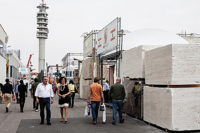
The Marmomacc trade fair in Verona, Italy, took place from September 30 to October 3, and once again confirmed its stature as the leading international stone fair. Overall, Marmomacc welcomed more than 53,000 visitors and more than 1,500 exhibitors, according to show organizer VeronaFiere.
Although the stone industry remains embroiled in one of the most difficult recessions in history, there have been some positive signs in recent months. These indicators continued at the Marmomacc trade fair in Verona, Italy, which took place from September 30 to October 3, and once again confirmed its stature as the leading international stone fair.
Overall, Marmomacc welcomed more than 53,000 visitors and more than 1,500 exhibitors from 54 countries, according to show organizer VeronaFiere, and they exhibited over an area of more than 830,000 net square feet of space.
“The show went better than we expected,” said Klint Olsen of Blick Industries of Laguna Beach, CA. “We took orders and made over 100 new contacts. Most of our visitors were interested in our product and seemed serious about buying.”
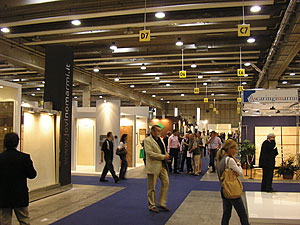
“We are at the side of companies, accompanying them in the growth process, and we are helping them from a promotional point of view to overcome this complex [economy] to highlight quality Italian products all over the world,” said Ettore Riello, President of VeronaFiere. “Today as never before, effective synergy between the production system, government, trade associations and institutions is vital so that we can work abroad with the necessary strength to tackle the global challenge posed by competition.”
The 24,000 foreign visitors at Marmomacc represented 45% of overall attendance, marking a slight increase over the previous year, and they came from more than 100 different nations.
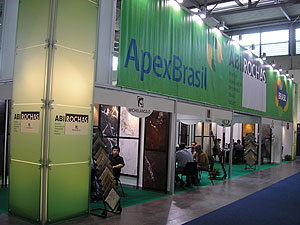
Approximately half of the exhibitors at Marmomacc came from outside of Italy, and companies from many countries organized in national pavilions, including Brazil.
Exhibitors at the event were an even mix of Italian companies (representing about half of the overall exhibitor total) and international firms representing 53 other countries, including, for the first time, Afghanistan, Algeria, Slovenia, Syria and Tunisia.
In addition to exhibitors of natural stone and quartz surfacing, the firms participating in Marmomacc offered large-scale stoneworking machinery and accessories as well as installation and maintenance products.

Among the exotic stones on display at Marmomacc, Primestone displayed blacklit Jade onyx. The company, which is based in Canada, produces onyx slabs at a facility in Italy.
Quartz surfacing also had an increased presence at Marmomacc, including products with UV resistance as well as products with unique surface textures or recycled content.
Moreover, the stone producers on hand at Marmomacc were eager to showcase traditional, popular materials that were extracted from newly developed quarry sites. This was of particular importance with regard to materials that have become harder to source in recent years.
Stone could be found in a broad range of formats at Marmomacc, including slabs, tiles, mosaics, blocks and architectural works such as customized cladding and three-dimensional pieces.

In addition to newly introduced stone materials, many companies announced the development of new quarry sites for traditional materials. For example, Pokarna Limited announced a new site for producing Tan Brown granite.
Technological developments at Marmomacc not only covered machinery, but also new treatments for stone, including products to strengthen fragile materials - allowing for the use of stone materials that might not otherwise be commercially viable.
(Editor’s Note: Please see “New introductions at Marmomacc and StonExpo/Marmomacc Americas” for descriptions of some of the specific stone materials, equipment and other innovations that were on display.)
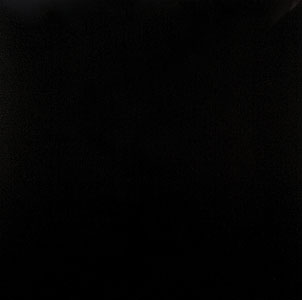
A pure black granite variety - Supreme Black granite - was on display at Tab India.
Marmomacc Meets Design
Design continues to be an important focus at Marmomacc, helping stone trade professionals to gauge the impact of the latest technologies. The “Marmomacc Meets Design” (MMD) project again generated some of the more innovative booth designs. MMD 2009 paired leading international designers with 13 stone processors. The pairings focused on this year’s theme - “hybrid and flexible” - in developing everything from objects - such as Tobia Scarpa’s stone stove for Testi Fratelli - to entire booth designs. The theme of flexibility was meant to apply not only to stone itself, but also to a design approach that involves pushing experimentation through technology to explore and redefine the material’s limits.

In addition to slabs, tiles and cut-to-size pieces, stone could also be found in block form at Marmomacc 2009.
Iaconcig’s booth, designed by Giovanni Vragnaz and Studio Modland, was chosen because of the surface treatment of the stone featured on the exterior of its booth, which transformed it into an “architectural element.”
A number of companies received “special mentions” from the jury for their booth designs: Antolini, Budri, Covelano Marmi, Franchi Umberto Marmi, Henraux, Lithos Design and MGM Furnari. PibaMarmi and Il Casone were also acknowledged by the jury for the continuity of their design strategies and the desire to push forward with research and experimentation even with young designers.

With an eye on the environment, Santamargherita displayed “Second.Life” engineered stone (pictured on the left), which has up to 95% recycled content. The design was completed by renowned designer Aldo Cibic as part of the Marmomacc Meets Design program.
Craig Copeland and Turan Duda’s collaboration with Henraux marked the first time that American architects have participated in MMD. Their design emerged through the pursuit of different types of material hybridizations to achieve new and varied effects of “flexibility” in stone. The combination of American Oak with Henraux’s own Cervaiole marble from the Carrara region in Tuscany helped to reinforce “fundamental realities and allusions to the flexibility of stone, both structurally and figuratively.”

For the second straight year, U.S.-based stone producers Rock of Ages and Cold Spring Granite Co. joined together to exhibit a variety of granite materials at Marmomacc.
(Editor’s Note: To view an interview with Duda and Copeland on their work with Henraux for MMD 2009, please visit Marmomacc’s YouTube channel atwww.youtube.com/user/marmomaccand click “Uploads.” Then scroll down to find the interview link.)
Marmomacc 2010 is scheduled to take place in Verona, Italy, from September 29 to October 2.
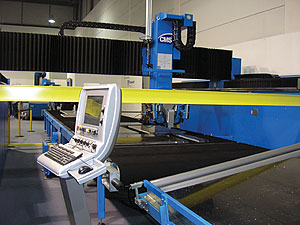
In the area of stoneworking machinery, exhibiting companies also introduced new innovations at Marmomacc, such as computerized bridge sawing machinery, shown here at the CMS/Brembana stand.
Additional Photos
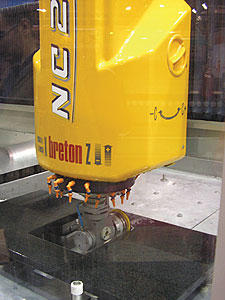
Many of the upgrades on display were specifically targeted towards shops specialized in countertop production, including developments in edge finishing. For example, Breton showcased a new attachment for CNC machinery that allows for polishing sinks with zero-radius corners.
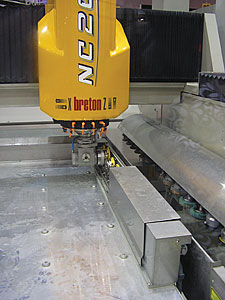
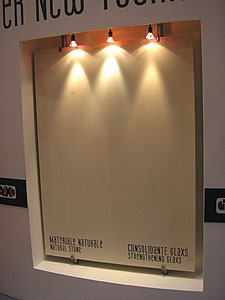
Outside of machinery, there were innovations such as a product from Tenax (“Glaxs”) for resin-treating slabs that will not turn yellow in UV light.

The “Marmomacc Meets Design” (MMD) project again generated some of the more innovative booth designs. MMD 2009 paired leading international designers with 13 stone processors, with the theme of “hybrid and flexible.” One of the MMD booths - Vaselli Marmi, with designers Marco Fagioli and Emanuel Gargano, gained a share of the Marmomacc “Best Communicator Award.” Vaselli was selected by the jury for its “originality and lightness, with which the strength of stone as a material was approached in the booth’s perimeter.”
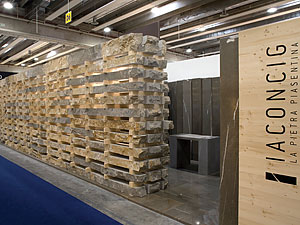
Iaconcig Pietra Piasentina’s MMD project also garnered a “Best Communicator Award.” Iaconcig’s booth, designed by Giovanni Vragnaz and Studio Modland, was chosen because of the surface treatment of the stone featured on the exterior of its booth, which transformed it into an “architectural element.”
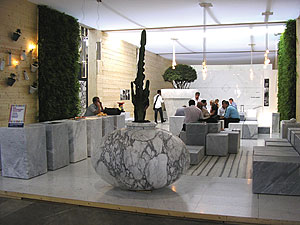
A number of companies received “special mentions” from the jury for their booth designs, including Franchi Umberto Marmi.

Craig Copeland and Turan Duda’s collaboration with Henraux marked the first time that American architects have participated in MMD. Their design emerged through the pursuit of different types of material hybridizations to achieve new and varied effects of “flexibility” in stone. The combination of American Oak with Henraux’s own Cervaiole marble from the Carrara region in Tuscany helped to reinforce “fundamental realities and allusions to the flexibility of stone, both structurally and figuratively.”
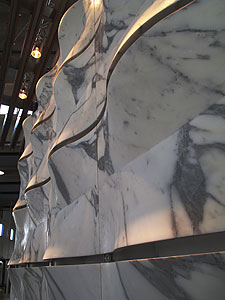
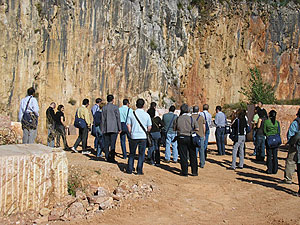
As part of VeronaFiere’s AIA continuing education program at Marmomacc, a total of 32 architects spent four days studying the relevance of stone to modern design. Among the educational sessions, participants toured the Essegimarmi Breccia Pernice quarry near Verona, Italy.
Sidebar: Marmomacc 2009 hosts 11th edition of AIA continuing education program
As part of its ongoing efforts to bridge the architecture and design community with architects and designers, Marmomacc hosted the 11th edition of VeronaFiere’s continuing education program for architects. The program now includes courses in Italy, the U.S. and online. A total of 32 architects - from the U.S., Canada, the U.K., India, South Africa, Australia, Singapore and Vietnam - spent four days studying the relevance of stone to modern design.Participants toured the Essegimarmi Breccia Pernice quarry near Verona, spent a day in the Val di Chiampo district at companies such as Decormarmi, Lithos Design and PibaMarmi, and even made a rare visit to Palladio’s La Rotonda.
Marmomacc’s continuing education program is recognized by the American Institute of Architects (AIA), the Royal Architectural Institute of Canada, the Royal Institute of British Architects, the Australian Institute of Architects and the South African Institute of Architects.

Participants also had the opportunity to visit stoneworking facilities to get a first-hand look at the stone fabrication process.
Additional Photos
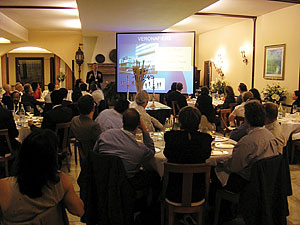
The tour was led by industry veteran and consultant Vince Marazita, and participants were also welcomed by Janina Mathiasz of VeronaFiere.

